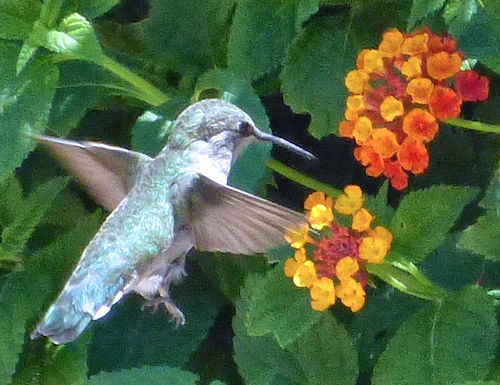Growing Lantana camara:
Lantana
Description
Form: Shrub.
Leaf retention: Evergreen but frost-deciduous.
Growth rate: Rapid.
Mature Size: Normally 2-4' (60-120cm) high and wide. Can grow to 6' (180cm) high.
Flowers: Small tubular flowers are clustered into hemispheres of various colors. After pollination, the color of each individual flower fades, often from red to orange, then yellow. This helps pollinators locate the flowers that still have nectar and need pollination. Pastel colored and solid gold hybrids are common.
Bloom: All year in regions without freezes. Blooms may not occur in the middle of winter.
Fruit: Small black or blue-black fruit. Ripe fruit are edible when fully dark. Most hybrids are sterile and do not produce fruit.
Leaves: Rough textured, green, serrate margins, to 3" (7.6cm) long. The leaves have a strong odor if crushed.
Stems: Tiny thorns on some cultivars.
Wildlife: Some cultivars are very attractive to butterflies, other cultivars do not interest or even repel them. Young hummingbirds occasionally investigate when the plant is in a container 3' (1m) or more off the ground. Birds are attracted if fruit are produced. These plants are avoided by mammals.
Toxic / Danger: All parts, except ripe (fully dark) fruit, are toxic to animals and humans. The ripe fruit may have patches of hard spikes on their rind which suggests they should be cooked before eating. The stems have small thorns.
Origin: Tropical America.
Form: Shrub.
Leaf retention: Evergreen but frost-deciduous.
Growth rate: Rapid.
Mature Size: Normally 2-4' (60-120cm) high and wide. Can grow to 6' (180cm) high.
Flowers: Small tubular flowers are clustered into hemispheres of various colors. After pollination, the color of each individual flower fades, often from red to orange, then yellow. This helps pollinators locate the flowers that still have nectar and need pollination. Pastel colored and solid gold hybrids are common.
Bloom: All year in regions without freezes. Blooms may not occur in the middle of winter.
Fruit: Small black or blue-black fruit. Ripe fruit are edible when fully dark. Most hybrids are sterile and do not produce fruit.
Leaves: Rough textured, green, serrate margins, to 3" (7.6cm) long. The leaves have a strong odor if crushed.
Stems: Tiny thorns on some cultivars.
Wildlife: Some cultivars are very attractive to butterflies, other cultivars do not interest or even repel them. Young hummingbirds occasionally investigate when the plant is in a container 3' (1m) or more off the ground. Birds are attracted if fruit are produced. These plants are avoided by mammals.
Toxic / Danger: All parts, except ripe (fully dark) fruit, are toxic to animals and humans. The ripe fruit may have patches of hard spikes on their rind which suggests they should be cooked before eating. The stems have small thorns.
Origin: Tropical America.
Cultivation and Uses
USDA hardiness zones: 9-11. Root hardy to 20°F (-6.7°C). In regions with freezes, it will grow back from its roots, after the start of spring, if it is properly mulched.
Heat tolerant: Yes.
Drought tolerant: Yes.
Sun: Full sun for best blooms.
Soil: Well draining, pH 6.1-7.8 (slightly acidic to slightly alkaline). This plant is adaptable to many soil types within those constraints.
Water once established: Monthly.
Mulch: Cover the extended root area well with organic mulch before the first predicted freeze.
First Year Care: Water thoroughly every day to establish an extensive root system.
Prune: Remove dead parts in late winter.
Litter: Low.
Propagation: Seed or cuttings. Cuttings have a 90% success rate.
Uses: Ornamental. The tasty ripe fruit from certain cultivars are collected and cooked into pies in some locations of the Americas.
USDA hardiness zones: 9-11. Root hardy to 20°F (-6.7°C). In regions with freezes, it will grow back from its roots, after the start of spring, if it is properly mulched.
Heat tolerant: Yes.
Drought tolerant: Yes.
Sun: Full sun for best blooms.
Soil: Well draining, pH 6.1-7.8 (slightly acidic to slightly alkaline). This plant is adaptable to many soil types within those constraints.
Water once established: Monthly.
Mulch: Cover the extended root area well with organic mulch before the first predicted freeze.
First Year Care: Water thoroughly every day to establish an extensive root system.
Prune: Remove dead parts in late winter.
Litter: Low.
Propagation: Seed or cuttings. Cuttings have a 90% success rate.
Uses: Ornamental. The tasty ripe fruit from certain cultivars are collected and cooked into pies in some locations of the Americas.
Comments
This plant is a member of the Verbena family (Verbenaceae). Many cultivars sold in nurseries are hybrids with varying degrees of cold hardiness. Cultivar 'Del Rio' repels butterflies. Other cultivars may attract them. At a nursery, watch which plants the butterflies visit.
The butterfly in the picture is a Sleepy Orange.
Lantana is considered an invasive and noxious weed in parts of California, Florida and Hawaii.
Do you have additional information or a different experience for these plants that you would like to share? Email info@GardenOracle.com. All contributions are welcome and appreciated.
This plant is a member of the Verbena family (Verbenaceae). Many cultivars sold in nurseries are hybrids with varying degrees of cold hardiness. Cultivar 'Del Rio' repels butterflies. Other cultivars may attract them. At a nursery, watch which plants the butterflies visit.
The butterfly in the picture is a Sleepy Orange.
Lantana is considered an invasive and noxious weed in parts of California, Florida and Hawaii.
Do you have additional information or a different experience for these plants that you would like to share? Email info@GardenOracle.com. All contributions are welcome and appreciated.




Latest update: September, 2025
© 2008-2025 by GardenOracle.com

